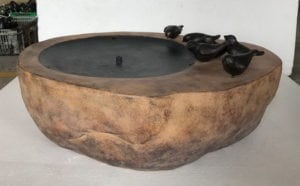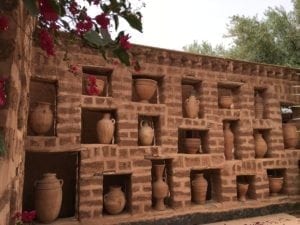
Choosing Your Water Feature: It is best to choose a water feature design that is fitting with the scale and style of you home while also keeping your lifestyles in mind. Ponds are popular water features and, like pools, come in both in-ground and above-ground styles. Above-ground ponds are easier and faster to build than in-ground ponds and may be safer options for parents of young children. Streams and waterfalls also are popular and can make use of natural variations in property grading. Fountains can be freestanding structures or a component of a pond or another body of water.
The location of the water feature can impact its maintenance. For example, a fountain or pond located directly under deciduous trees will require more frequent cleaning to remove leaves and tree debris. Ponds that receive direct sunlight may have more pronounced algae growth.
Maintaining Your Water Feature: Water features require the constant flow of water to prevent stagnation and proliferation of mosquito and other insect larvae. This in turn requires a pump to push the water around. The water pump should be securely situated on level ground so that vibrations will not cause the pump to move around and eventually loosen fittings.
Even pumps protected by an intake filter or screen can become clogged with debris. It's necessary to routinely inspect the screen and the pump filter and remove any obstructions. Otherwise, the pump motor can overheat and malfunction.
Finding Ideal balance: Similar to pools, algae can be the root of all evil in garden features. Controlling nutrients, which may involve watching the levels of nitrogen compounds and phosphorous, will help control the algae.
Avoid locating the water feature where lawn and garden runoff will find its way into the water. Filtration and routine testing of water levels also can help. Water features that are not meant to become wildlife habitats may benefit from a mild sanitizer to keep algae at bay. A thorough cleaning of liners at the end of the season to eliminate materials that build up on the bottom can help, too.
Preparing for Cold Weather: In winter you decide if you want to keep the water feature running or shut it down. This is the time to cut back the dead plant material and remove any unwanted elements from the water. Remove pumps and drain water feature lines so they can so to avoid freezing.

 Cast Stone Fountains: Cast stone structures are constructed with a Portland cement mixture that includes high quality fine and course aggregates. The increased amounts of fine aggregates result in a smooth surface resembling that of natural cut stone. Pigments can be added to the mixture to change the base colour. A final "antiquing" process can also be done to add a two-tone aspect to the piece.
Cast Stone Fountains: Cast stone structures are constructed with a Portland cement mixture that includes high quality fine and course aggregates. The increased amounts of fine aggregates result in a smooth surface resembling that of natural cut stone. Pigments can be added to the mixture to change the base colour. A final "antiquing" process can also be done to add a two-tone aspect to the piece.
Glass Fibre Reinforced Concrete (GFRC) Fountains: This material is comprised of high strength glass fibre embedded in a cement mixture making it the most durable of all the outdoor fountain materials. In fact, when manufactured correctly, GFRC can have a higher tensile strength than steel. The obvious advantages of this material make it valuable to building and decor.
Polystone Fountains: This material can be made to mimic virtually any material including concrete, rock, wood or ceramic. Polystone was developed to weigh only 20% of cast stone structures while keeping the same durability ratings. It is also a much cheaper material than cast stone, making it very desirable for decorative garden structures. The making of the polystone compound involves mainly a polyurethane resin mixed with a powdered stone additive, creating an almost stone-like look and feel. Most popular material so far.
Fiberglass (GFRP - Glass Fiber Reinforced Plastic) Fountains: The lightest of all the materials, weighing in average 15% of cast stone structures, makes the fiberglass fountains the easiest to manage and assemble. However, in windy areas where the fountain may get blown over, durability could be a concern. As the name suggests, fiberglass is made from tiny glass fibres and an epoxy material, which is mixed and moulded into practically any size and shape desired. Tend to be used for large fountains given its light weight.
Stainless Steel Fountains: Stainless steel is one of the best building materials ever discovered. Because of the anti-oxidation and stain-free properties, fountains made of stainless steel never discolour or rust. The strength of stainless allows for thin sheets to be used to lessen the weight and cost while maintaining the durability of the structure.
Copper Fountains: Copper fountains are the epitome of class and elegance. The various patinas and finishes that occur to this beautiful natural resource are phenomenal. Many of the patinas develop over time and continue to add to the beauty of the structure. However, due to the cost, copper fountain designs are uncommon but you could choose to get one custom made.
Granite & Natural Stone Fountains: Fountains cut from natural stone tend to be simple in design but for obvious reasons, are one of the most natural looking of all fountains. The minerals typically used for stone fountains include granite, slate & marble because of their beautiful colour combinations and abundance.
